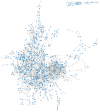Mind the Gap: Mapping Mass Spectral Databases in Genome-Scale Metabolic Networks Reveals Poorly Covered Areas
- PMID: 30223552
- PMCID: PMC6161000
- DOI: 10.3390/metabo8030051
Mind the Gap: Mapping Mass Spectral Databases in Genome-Scale Metabolic Networks Reveals Poorly Covered Areas
Abstract
The use of mass spectrometry-based metabolomics to study human, plant and microbial biochemistry and their interactions with the environment largely depends on the ability to annotate metabolite structures by matching mass spectral features of the measured metabolites to curated spectra of reference standards. While reference databases for metabolomics now provide information for hundreds of thousands of compounds, barely 5% of these known small molecules have experimental data from pure standards. Remarkably, it is still unknown how well existing mass spectral libraries cover the biochemical landscape of prokaryotic and eukaryotic organisms. To address this issue, we have investigated the coverage of 38 genome-scale metabolic networks by public and commercial mass spectral databases, and found that on average only 40% of nodes in metabolic networks could be mapped by mass spectral information from standards. Next, we deciphered computationally which parts of the human metabolic network are poorly covered by mass spectral libraries, revealing gaps in the eicosanoids, vitamins and bile acid metabolism. Finally, our network topology analysis based on the betweenness centrality of metabolites revealed the top 20 most important metabolites that, if added to MS databases, may facilitate human metabolome characterization in the future.
Keywords: mass spectral libraries; metabolic networks; metabolite annotation; metabolomics data mapping.
Conflict of interest statement
Authors declare no conflict of interest.
Figures








Similar articles
-
[A novel method for efficient screening and annotation of important pathway-associated metabolites based on the modified metabolome and probe molecules].Se Pu. 2022 Sep;40(9):788-796. doi: 10.3724/SP.J.1123.2022.03025. Se Pu. 2022. PMID: 36156625 Free PMC article. Chinese.
-
Translational Metabolomics of Head Injury: Exploring Dysfunctional Cerebral Metabolism with Ex Vivo NMR Spectroscopy-Based Metabolite Quantification.In: Kobeissy FH, editor. Brain Neurotrauma: Molecular, Neuropsychological, and Rehabilitation Aspects. Boca Raton (FL): CRC Press/Taylor & Francis; 2015. Chapter 25. In: Kobeissy FH, editor. Brain Neurotrauma: Molecular, Neuropsychological, and Rehabilitation Aspects. Boca Raton (FL): CRC Press/Taylor & Francis; 2015. Chapter 25. PMID: 26269925 Free Books & Documents. Review.
-
MINEs: open access databases of computationally predicted enzyme promiscuity products for untargeted metabolomics.J Cheminform. 2015 Aug 28;7:44. doi: 10.1186/s13321-015-0087-1. eCollection 2015. J Cheminform. 2015. PMID: 26322134 Free PMC article.
-
Metabolome searcher: a high throughput tool for metabolite identification and metabolic pathway mapping directly from mass spectrometry and using genome restriction.BMC Bioinformatics. 2015 Feb 25;16(1):62. doi: 10.1186/s12859-015-0462-y. BMC Bioinformatics. 2015. PMID: 25887958 Free PMC article.
-
An Experimental Approach to Genome Annotation: This report is based on a colloquium sponsored by the American Academy of Microbiology held July 19-20, 2004, in Washington, DC.Washington (DC): American Society for Microbiology; 2004. Washington (DC): American Society for Microbiology; 2004. PMID: 33001599 Free Books & Documents. Review.
Cited by
-
Metabolomics and Multi-Omics Integration: A Survey of Computational Methods and Resources.Metabolites. 2020 May 15;10(5):202. doi: 10.3390/metabo10050202. Metabolites. 2020. PMID: 32429287 Free PMC article. Review.
-
The human microbial exposome: expanding the Exposome-Explorer database with gut microbial metabolites.Sci Rep. 2023 Feb 2;13(1):1946. doi: 10.1038/s41598-022-26366-w. Sci Rep. 2023. PMID: 36732606 Free PMC article.
-
Assessing the Impact of Measurement Precision on Metabolite Identification Probability in Multidimensional Mass Spectrometry-Based, Reference-Free Metabolomics.Anal Chem. 2025 Jul 8;97(26):13861-13871. doi: 10.1021/acs.analchem.5c01067. Epub 2025 Jun 25. Anal Chem. 2025. PMID: 40556554 Free PMC article.
-
Pathway analysis in metabolomics: Recommendations for the use of over-representation analysis.PLoS Comput Biol. 2021 Sep 7;17(9):e1009105. doi: 10.1371/journal.pcbi.1009105. eCollection 2021 Sep. PLoS Comput Biol. 2021. PMID: 34492007 Free PMC article.
-
SingleFrag: a deep learning tool for MS/MS fragment and spectral prediction and metabolite annotation.Brief Bioinform. 2025 Jul 2;26(4):bbaf333. doi: 10.1093/bib/bbaf333. Brief Bioinform. 2025. PMID: 40641047 Free PMC article.
References
-
- Panopoulos A.D., Yanes O., Ruiz S., Kida Y.S., Diep D., Tautenhahn R., Herrerías A., Batchelder E.M., Plongthongkum N., Lutz M., et al. The metabolome of induced pluripotent stem cells reveals metabolic changes occurring in somatic cell reprogramming. Cell Res. 2012;22:168–177. doi: 10.1038/cr.2011.177. - DOI - PMC - PubMed
Grants and funding
LinkOut - more resources
Full Text Sources
Other Literature Sources
Miscellaneous

